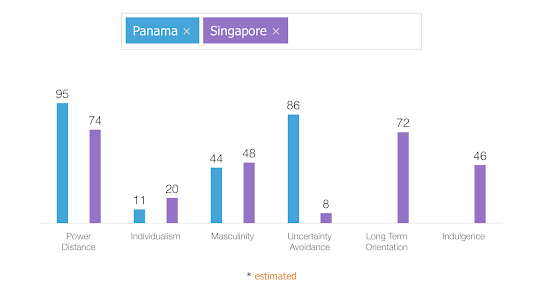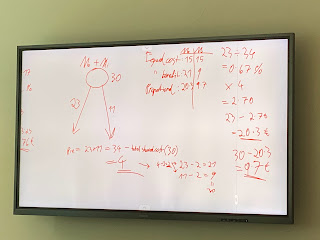Cross-Cultural Training Session 2 and 3
In the start of the second session, we started with the topic of power distance. We analyzed what power distance is and how power distance works in an organizational culture (bringing back the professor's experience working in Italy and how a marketing manager would always wait for the professor to delegate and control what and how she does her work). Gabriela also brought up her mother's experience working back in Panama and having to approve and accept every actions from her workers.
How to interpret Power Distance:
- Decentralisation / integration decision making
- Hierarchies (many or flat) based on achievement (can change) or ascription (family members or nepotism)
- Respect/independence --> leadership, as a manager you get respect of your employees not because of your position but because you are doing a good job.
- Income distribution. Generally in cultures with a higher power distance, it is more accepted that you have a more uneven income distribution.
Examples:
- Goals or task-based manager
There are certain issues that arise when dealing with companies abroad. When the professor asked for a sales result of a daughter company abroad to his controller, the task of controller was to go to the financial manager of the daughter company. He wrote an email to the FM but the FM ignored it, delaying the report as a result. The controller said that he is not getting the data. What is expected is that the Branch Manager would prefer to discuss with the professor in a High Power Distance Index. And little issues that should be manageable is being tossed back and forth and works would be more keen in discussing with the bosses instead.
When we analyse the graphs, we look for similarities and differences. As the model is quantitative, culture is qualitative. If the values are very close, or anything below 10, it can be considered as a similarities and anything that is above 10 can be considered as a difference. We can also have differences if we have a country, let's say Switzerland, 34, and Austria, 11, both values are different but they are below the threshold, thus, they both have low power distance. That is where we can see the commonalities in which things are managed between countries.
In the second session, we went into the other dimensions and developed it as a group, then we did a group presenation on the different dimensions according to our chosen countries. We were surprised by some of the results but understood it further with the explanation by the professor. For example: Switzerland had a higher score in Masculinity compared to the three other countries, such as Panama, Singapore and Thailand and we thought it was a bit strange. But then, with the explanation from the professor, it turns out that Masculinity is more based on the nature of being career-focused, success, and achievements and Femininity refers to the feminine nature of caring, family and quality of life. So, after that reasoning, it became more clear as to why Switzerland was much higher in the Masculinity aspect.
After the break, we tried to compare two differennt cultures with each other. Comparison between Singapore and the United Kingdom. We can take all of the values from the dimensions, then calculate the difference between each dimensions and we can see how large the difference of culture is.
Then, we analyzed the difference between two cultures. The biggest difference between Singapore and Panama is within the Uncertainty Avoidance where SG has 8 and Panama has 86. Our total difference adds up to 204.
Cultural Distance SG - Panama Distance > 10 pts Distance < 10 pts
Netural: Power Distance (difference higher than 10), Individualism, masculinity (difference lower than 10).
High and Low: Uncertainty avoidance, long term orientation, and indulgence vs. restraints (onne is high and one is really low and the difference is higher than 10).



Comments
Post a Comment